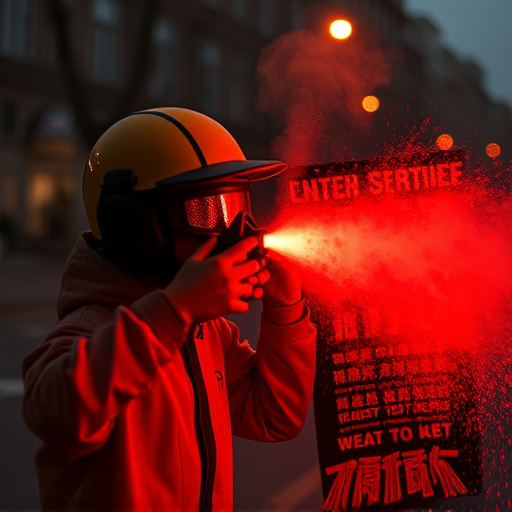Riot control agents like pepper spray are powerful tools for law enforcement but carry significant risks, including respiratory distress and temporary blindness caused by capsaicin irritation. Misconceptions about its blinding capabilities persist, emphasizing the need for proper training, equipment, and understanding of risks to balance crowd control with citizen safety. Legal regulations vary globally, strictly controlling these agents as a last resort, while law enforcement agencies explore alternative strategies like drones, sound-based devices, and data analytics to minimize harm, enhance officer safety, and maintain public order effectively, moving away from traditional methods that cause injury or disability.
Riot control agents are a critical tool in law enforcement, but their use comes with stringent legal and ethical considerations. This article delves into the world of these powerful substances, offering a comprehensive overview of riot control agents, focusing on the popular yet controversial pepper spray. We explore its effects, debunk common myths, and analyze the legal framework guiding its application. Additionally, we examine alternative strategies and emerging trends shaping the future of riot control tactics. Understanding these elements is crucial for both law enforcement professionals and the public at large.
- Understanding Riot Control Agents: An Overview
- Pepper Spray and Its Effects: Debunking Myths
- Legal Framework and Guidelines for Law Enforcement
- Alternative Strategies and Future Trends in Riot Control
Understanding Riot Control Agents: An Overview
Riot control agents are a crucial tool in law enforcement, designed for managing and dispersing crowds during civil unrest or large-scale events. These chemical compounds come in various forms, each with unique properties and effects on the human body. One commonly used agent is pepper spray, which contains capsaicin, the active ingredient found in chili peppers. Despite its name, pepper spray doesn’t necessarily blind users; rather, it irritates the eyes, nose, and throat, temporarily disabling these sensory functions.
The impact of riot control agents goes beyond immediate physical symptoms. Exposure can lead to respiratory distress, panic attacks, and even cardiovascular issues, especially in vulnerable individuals or those in close quarters. It’s important for law enforcement agencies to provide proper training and equipment to officers using these agents, ensuring they understand the risks and safe application methods. Additionally, understanding the legal implications and public perception surrounding riot control agents is essential for maintaining a balance between crowd control and citizen safety.
Pepper Spray and Its Effects: Debunking Myths
Pepper spray, a common riot control agent used by law enforcement and security personnel worldwide, has sparked debates due to its potential side effects. One prevalent myth is that pepper spray can blind users instantly. However, this claim is far from accurate. Pepper spray functions by irritating the eyes, nose, throat, and respiratory system through capsaicin, the active ingredient responsible for the burning sensation. While it can cause temporary blindness or visual impairment due to excessive tears and inflammation, complete blindness is highly unlikely. The effects are usually temporary, lasting only a few minutes.
Understanding the reality behind pepper spray’s capabilities is essential for both law enforcement agencies and the public. It empowers individuals to make informed decisions about self-defense and promotes safer tactics during volatile situations. Debunking these myths ensures that people have access to accurate information, fostering a more responsible approach to riot control and personal safety.
Legal Framework and Guidelines for Law Enforcement
The legal framework governing riot control agents, including pepper spray, varies across jurisdictions but generally falls under broader laws and regulations related to public safety and law enforcement procedures. In many countries, the use of such agents is strictly regulated to ensure they are employed as a last resort and in accordance with human rights principles. Law enforcement agencies must adhere to guidelines that delineate when, where, and how these agents can be deployed, focusing on minimizing harm to both suspects and bystanders.
When it comes to specific agents like pepper spray, legal considerations often include restrictions on its potency and the conditions under which it may be used. For instance, while pepper spray is a widely utilized non-lethal weapon, it’s crucial to understand that it can cause temporary blindness, respiratory distress, and other health issues, as implied by concerns about its ability to “blind you.” Therefore, legal guidelines meticulously outline scenarios where its use is permissible, ensuring accountability and proportionality in law enforcement practices.
Alternative Strategies and Future Trends in Riot Control
In recent years, law enforcement agencies have been exploring alternative strategies in riot control to supplement traditional methods. One notable trend is the shift towards less-lethal weapons and tactics that minimize injury and reduce the risk of permanent disability. For instance, while pepper spray remains a popular choice for its quick knockdown effect, it’s important to note that it can cause temporary blindness and respiratory distress—a concern that has spurred the development of alternative agents with similar efficacy but reduced side effects.
Future trends in riot control look towards technology-driven solutions, such as advanced crowd control drones and sound-based devices designed to disorient without causing physical harm. Additionally, data analytics play a growing role, with law enforcement leveraging real-time intelligence to predict and mitigate potential hotspots. These innovative approaches aim to enhance officer safety, minimize civilian casualties, and maintain public order more effectively, reflecting a broader shift towards more nuanced and proportional responses to civil unrest.
Riot control agents, such as pepper spray, play a significant role in law enforcement strategies worldwide. While debunking myths about its blinding capabilities is essential, understanding the legal framework and exploring alternative methods is crucial for responsible and effective use. As we move forward, embracing innovative trends in riot control can help maintain public safety while minimizing harm. By balancing these approaches, law enforcement agencies can navigate challenging situations with both efficiency and humanity.
